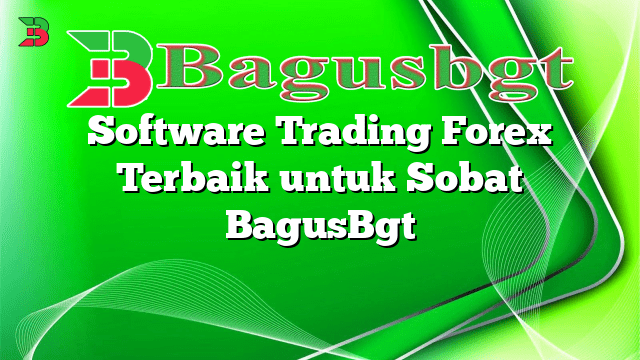Hello readers, welcome to our comprehensive guide on forex trading terms. In this article, we will provide you with detailed explanations of key terms related to forex trading. Whether you are a beginner or an experienced trader, understanding these terms is crucial for success in the forex market.
1. Pip
A pip, short for “percentage in point,” is the smallest unit of measurement for currency movements. It represents the fourth decimal place in most currency pairs. For example, if the EUR/USD pair moves from 1.2000 to 1.2001, it means the price has increased by 1 pip.
Advantages of understanding pips:
- Allows you to calculate potential profits or losses accurately
- Helps in setting stop-loss and take-profit levels
Disadvantages of pips:
- Pips do not consider the impact of spreads
- Can be confusing for beginners
2. Spread
The spread refers to the difference between the bid price and the ask price of a currency pair. It represents the cost of trading and is measured in pips. Brokers earn money through spreads.
Advantages of spreads:
- Transparency in trading costs
- Allows traders to compare different brokers
Disadvantages of spreads:
- Increases the cost of entering a trade
- Can vary significantly between brokers and currency pairs
3. Margin
Margin is the amount of money required to open a position in the forex market. It acts as collateral and allows traders to control larger positions with a smaller amount of capital. Margin is expressed as a percentage.
Advantages of margin:
- Provides leverage, amplifying potential profits
- Allows traders with limited capital to participate in the market
Disadvantages of margin:
- Increases the risk of losses
- Margin calls can lead to forced liquidation of positions
4. Stop-Loss Order
A stop-loss order is an instruction given to a broker to automatically close a position when the market reaches a specified price level. It is used to limit potential losses.
Advantages of stop-loss orders:
- Protects traders from excessive losses
- Eliminates the need for constant monitoring of trades
Disadvantages of stop-loss orders:
- Can be triggered by short-term market fluctuations
- Does not guarantee execution at the specified price
5. Take-Profit Order
A take-profit order is an instruction given to a broker to automatically close a position when the market reaches a specified profit level. It is used to secure potential gains.
Advantages of take-profit orders:
- Locks in profits and prevents potential reversals
- Eliminates emotional decision-making
Disadvantages of take-profit orders:
- May cause premature exits if the market continues to move in favor of the trade
- Does not guarantee execution at the specified price
6. Lot Size
Lot size refers to the number of units of a currency pair that are traded in a single transaction. It determines the size of the position and the value of a pip.
Advantages of lot size:
- Allows flexibility in position sizing
- Accommodates different risk tolerance levels
Disadvantages of lot size:
- Higher lot sizes require larger capital
- Increases the potential risk and reward of a trade
7. Leverage
Leverage is the ability to control a larger position with a smaller amount of capital. It is expressed as a ratio, such as 1:100. Leverage amplifies both profits and losses.
Advantages of leverage:
- Allows traders to enter larger trades with limited capital
- Potential for higher returns on investment
Disadvantages of leverage:
- Increases the risk of losses
- Requires proper risk management to avoid margin calls
8. Candlestick Chart
A candlestick chart is a popular tool used by forex traders to analyze price movements. It displays the opening, closing, high, and low prices for a specific time period in a visually appealing way.
Advantages of candlestick charts:
- Provides valuable information about price patterns and market sentiment
- Easy to interpret and use for decision-making
Disadvantages of candlestick charts:
- Requires understanding of candlestick patterns and technical analysis
- May generate false signals in volatile markets
9. Fundamental Analysis
Fundamental analysis involves evaluating economic, social, and political factors that can influence currency prices. It focuses on macroeconomic indicators, such as interest rates, inflation, and GDP.
Advantages of fundamental analysis:
- Provides a long-term perspective on currency movements
- Helps in understanding the underlying value of a currency
Disadvantages of fundamental analysis:
- Requires significant research and analysis
- Market reactions may not always align with fundamental expectations
10. Technical Analysis
Technical analysis involves studying historical price data and using indicators to predict future price movements. It focuses on patterns, trends, and market psychology.
Advantages of technical analysis:
- Provides short-term trading opportunities
- Helps in identifying support and resistance levels
Disadvantages of technical analysis:
- Relies on historical data, which may not always repeat itself
- Can generate false signals in volatile or unpredictable markets
Alternative Approach: Algorithmic Trading
Algorithmic trading, also known as automated trading, involves using computer programs to execute trades based on predefined rules and algorithms. It eliminates human emotions and biases from the trading process.
Advantages of algorithmic trading:
- Allows for faster execution of trades
- Reduces the impact of human errors and emotions
Disadvantages of algorithmic trading:
- Requires programming skills and technical knowledge
- May lead to significant losses if algorithms are not properly tested or monitored
Forex Trading Terms Table
| Term | Definition |
|---|---|
| Pip | The smallest unit of measurement for currency movements |
| Spread | The difference between the bid price and the ask price of a currency pair |
| Margin | The amount of money required to open a position |
| Stop-Loss Order | An instruction to automatically close a position at a specified price level |
| Take-Profit Order | An instruction to automatically close a position at a specified profit level |
| Lot Size | The number of units of a currency pair traded in a single transaction |
| Leverage | The ability to control a larger position with a smaller amount of capital |
| Candlestick Chart | A chart that displays price movements in a visually appealing way |
| Fundamental Analysis | Evaluating economic, social, and political factors that influence currency prices |
| Technical Analysis | Studying historical price data to predict future price movements |
Frequently Asked Questions (FAQ)
Q: How can I start trading forex?
A: To start trading forex, you will need to open an account with a reputable forex broker. Once your account is set up, you can deposit funds and begin placing trades using the trading platform provided by the broker. It is recommended to start with a demo account to practice trading strategies before risking real money.
Q: What is a currency pair?
A: A currency pair is the quotation of two different currencies, with the value of one currency being expressed in terms of the other. For example, the EUR/USD pair represents the euro against the U.S. dollar. Trading forex involves buying one currency and simultaneously selling another currency in the pair.
Q: What is the difference between a market order and a pending order?
A: A market order is an instruction to buy or sell a currency pair at the best available price in the market. It is executed immediately. On the other hand, a pending order is an instruction to buy or sell a currency pair at a specific price level in the future. The trade will be executed only when the market reaches the specified price.
Q: What are the major currency pairs?
A: The major currency pairs are the most frequently traded pairs in the forex market. They include EUR/USD, GBP/USD, USD/JPY, USD/CHF, AUD/USD, and USD/CAD. These pairs have high liquidity and typically have lower spreads compared to other currency pairs.
Q: What is a rollover/swap in forex trading?
A: Rollover, also known as a swap, refers to the interest paid or earned for holding a position overnight. When trading forex, each currency has an associated interest rate. If you hold a position past the end of the trading day, the interest rate differential between the two currencies will be either added or deducted from your account.
Q: Can I trade forex 24 hours a day?
A: Yes, the forex market is open 24 hours a day, five days a week. Trading begins on Sunday evening (GMT) and ends on Friday evening (GMT). However, it is important to note that certain currency pairs may have limited liquidity during specific trading sessions.
Q: What is slippage in forex trading?
A: Slippage refers to the difference between the expected price of a trade and the price at which the trade is actually executed. It can occur during periods of high market volatility or when there is a delay between the time the order is placed and when it is filled. Slippage can result in a trade being executed at a worse price than anticipated.
Q: How can I manage the risks in forex trading?
A: Risk management is crucial in forex trading to protect your capital. Some risk management techniques include setting stop-loss orders to limit potential losses, using proper position sizing, and diversifying your trading portfolio. It is also important to have a solid understanding of technical and fundamental analysis to make informed trading decisions.
Q: Can I make a living from forex trading?
A: While it is possible to make a living from forex trading, it requires a significant amount of knowledge, experience, and discipline. Success in forex trading depends on various factors, including market conditions, trading strategies, risk management, and emotional control. It is advisable to start with a realistic expectation and gradually increase your trading capital as you gain more experience.
Q: Are there any risks associated with forex trading?
A: Yes, forex trading involves risks. The market is highly volatile and can experience rapid price movements. There is a possibility of losing your entire investment if proper risk management is not followed. It is important to educate yourself, use demo accounts for practice, and never risk more than you can afford to lose.
Conclusion
In conclusion, understanding forex trading terms is essential for anyone looking to enter the forex market. From pips and spreads to leverage and candlestick charts, each term plays a significant role in the trading process. By familiarizing yourself with these terms and their advantages and disadvantages, you can make more informed trading decisions and improve your chances of success in the forex market.
Remember, forex trading involves risks, and it is important to approach it with caution and proper risk management. Continuously educate yourself, stay updated with market news and trends, and practice on demo accounts before risking real money. With dedication and the right mindset, forex trading can be a rewarding endeavor.
 Bagus Banget Kumpulan Informasi terbaru dari berbagai sumber yang terpercaya
Bagus Banget Kumpulan Informasi terbaru dari berbagai sumber yang terpercaya



